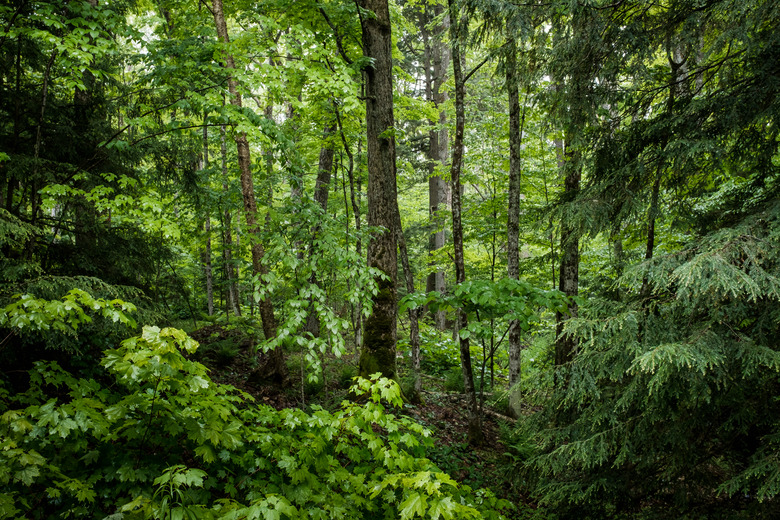Food Chains In A Woodland Habitat
Food chains and food webs vary depending on the habitat. Woodlands also vary, depending on the area. The main types of woodlands are coniferous forests, temperate deciduous forests and rainforests. Even these categories can be subdivided, as with temperate and tropical rainforests. In all woodlands, however, the food chains start with trees, the dominant plant form.
Woodland Habitats
Woodland Habitats
Trees are the common factor of woodland habitats. Woodland habitats vary, mostly by latitude but also by elevation. In general, woodland labels depend on the dominant tree population.
Coniferous forests, dominated by conifers, generally lie between the arctic tundra and the deciduous forests to the south. Coniferous forest trees, mostly evergreens, include spruces, pines and firs.
Deciduous forests undergo all four seasons. Most trees lose their leaves in the fall. Common trees in the deciduous forest include oaks, maples, birch and chestnuts.
Rainforests receive over 100 inches of rain per year. Rainforests can be subdivided into temperate rainforests, found mostly in temperate coastal areas, and tropical rainforests, found closer to the equator. Temperate rainforests are dominated by conifers. Tropical rainforests are also dominated by evergreens, many with large leaves adapted to shed the heavy rain.
Woodland Food Chain
Woodland Food Chain
Any woodland food chain begins, as most food chains do, with the producers. Trees produce seeds, which are eaten by first order consumers like squirrels and birds. Grasses and shrubs provide additional food for first order consumers including mice and deer. Second (secondary) and third (tertiary) order consumers feed off the first and second order consumers. Ultimately, the decomposers break down the bodies of producers and consumers, releasing the nutrients back to the environment. The woodland food web forms from the interconnected food chains. While the species may vary from one biome to another, the flow of energy from producers to consumers to decomposers remains consistent.
Coniferous Forest Food Chain
Coniferous Forest Food Chain
Producers in the coniferous woodland include conifers – which produce cones with seeds rather than flowers – shrubs and grasses. One simplified food chain is grass eaten by deer, the deer eaten by a mountain lion and the mountain lion's body decomposed by bacteria and fungi. Another food chain consists of pine cone seeds eaten by squirrels, squirrels eaten by hawks and hawk bodies decomposed by bacteria and fungi. Another food chain consists of seeds eaten by insects, insects eaten by fish, fish eaten by bears and bear bodies decomposed by bacteria and fungi.
Deciduous Forest Food Chain
Deciduous Forest Food Chain
Seasonal changes impact consumers in the temperate deciduous forest food web. Many of the producers in the deciduous forest develop flowers in the spring and fruit in the summer and fall. Bees and birds feed on the nectar and fruit. Bees may be eaten by skunks, bears and insectivorous birds. Birds are eaten by other birds like hawks, falcons and owls. Another food chain, similar to the coniferous forest food chain, starts with grass or fruit eaten by mice and deer. Mice may be eaten by foxes or owls. Deer may be eaten by cougars (mountain lions). The bodies of all members of the food chain are decomposed by bacteria and fungi. Tertiary consumers in the temperate deciduous forest food web include cougars, wolves and bears.
Temperate Rainforest Food Chain
Temperate Rainforest Food Chain
Producers in the temperate rainforest include canopy conifers like firs, cedars, hemlock and spruce, as well as understory vines, maples and dogwoods, and forest floor mosses, ferns and shrubs. First order consumers in the temperate rainforest range from chipmunks, squirrels and mice to salmon to insects to birds to deer and elk. Second order consumers include owls, falcons and hawks, weasels and raccoons, insects and amphibians. Third order consumers include wolves, lynx, bears and cougars. Decomposers include bacteria, protozoans and fungi.
Tropical Rainforest Food Chain
Tropical Rainforest Food Chain
The biodiversity of tropical rainforests provides many possible food chains. Each of the four layers of the rainforest, while not mutually exclusive, supports a variety of life. The producers include the canopy trees, vines, epiphytes and many flowering plants. First order consumers like insects, monkeys, parrots and bats eat fruit. Snakes and raptors eat the parrots and bats, and jaguars and larger snakes like boa constrictors and anacondas eat smaller snakes, monkeys and parrots. Another food chain starts with flowers. Insects feed on the nectar, bats eat the insects and snakes or birds eat the bats. Decomposers in the rainforest include bacteria, protozoans and fungi. Food chains combine to form complicated food webs for the tropical rainforest.
Cite This Article
MLA
Blaettler, Karen G. "Food Chains In A Woodland Habitat" sciencing.com, https://www.sciencing.com/food-chains-woodland-habitat-5556965/. 22 November 2019.
APA
Blaettler, Karen G. (2019, November 22). Food Chains In A Woodland Habitat. sciencing.com. Retrieved from https://www.sciencing.com/food-chains-woodland-habitat-5556965/
Chicago
Blaettler, Karen G. Food Chains In A Woodland Habitat last modified March 24, 2022. https://www.sciencing.com/food-chains-woodland-habitat-5556965/
